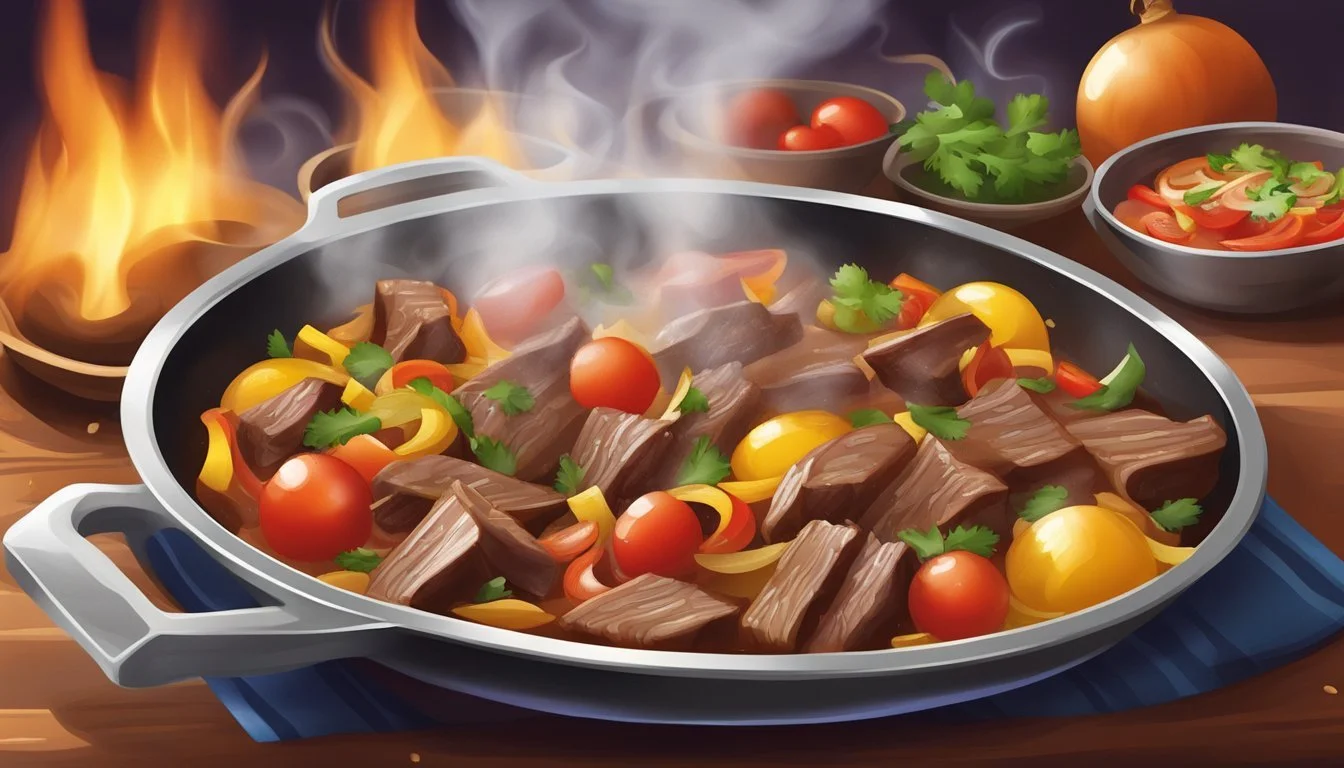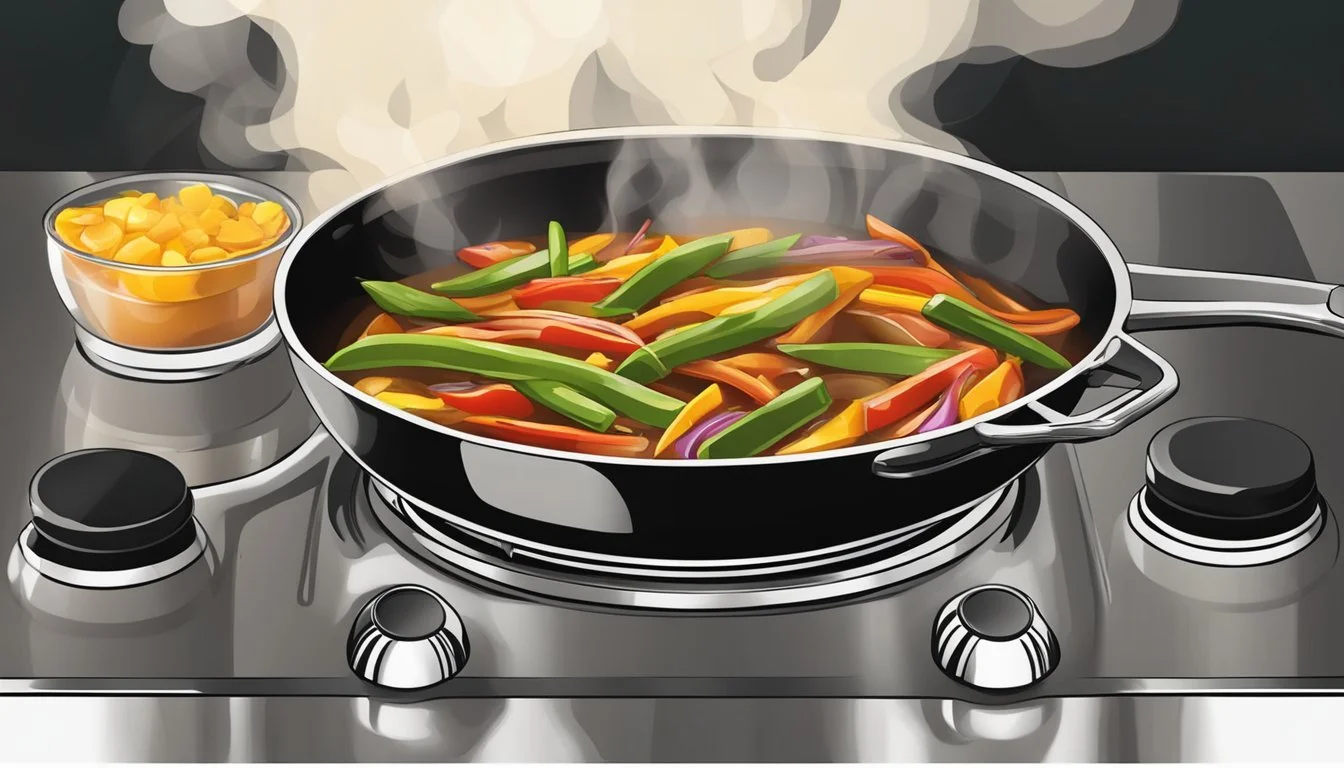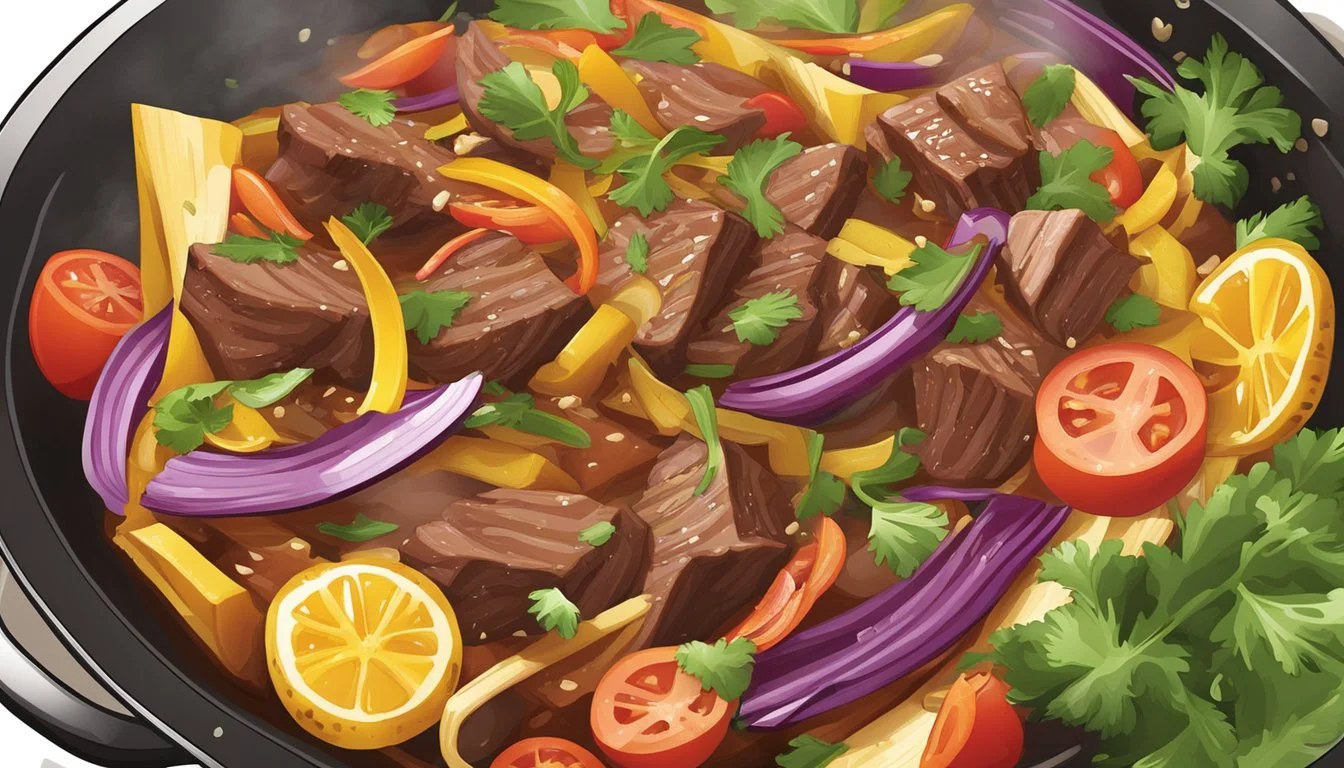Best Way to Reheat Lomo Saltado
Keeping the Flavor Alive
Lomo Saltado is a staple dish in Peruvian cuisine that combines marinated strips of sirloin with onions, tomatoes, and other ingredients, typically served with fries and rice. Its savory and tangy flavor is a testament to the fusion of Peruvian and Asian culinary techniques, embodying the heart of Peruvian comfort food. Achieving the authentic taste of Lomo Saltado relies on how it is reheated, as the process can significantly affect the texture and flavor of the dish.
To retain the inherent flavors of Lomo Saltado when reheating, it is crucial to consider the components that make the dish unique, such as the tenderness of the beef and the freshness of the vegetables. The method used to reheat the dish can either enhance its taste or diminish its vibrant qualities. Therefore, understanding the best way to reheat Lomo Saltado while preserving its exceptional taste is important for anyone looking to enjoy an authentic Peruvian culinary experience at home.
Reheating Lomo Saltado effectively requires a balance between restoring the warmth and maintaining the dish’s characteristic char and tenderness. The ideal approach takes into account the different textures involved, from the succulent beef to the crisp vegetables, and ensures that each element is gently warmed through without overcooking. Whether using a skillet over the stove or employing other reheating techniques, the key is to recreate the fresh-off-the-wok essence that Lomo Saltado is celebrated for.
Understanding Lomo Saltado
Lomo Saltado is more than just a Peruvian dish; it encapsulates the rich cultural fusion and showcases a harmony of flavors that have come to define Peruvian-Chinese, or "Chifa," cuisine.
Origins and Cultural Significance
Peru is the birthplace of Lomo Saltado, a beloved dish that emerged from the culinary traditions of Chinese immigrants in South America, mainly the Peruvian-Chinese community. Often considered an emblematic representation of Chifa cuisine, Lomo Saltado is a testament to the seamless integration of Asian cooking techniques with South American ingredients, creating a unique and popular aspect of Peruvian food culture.
Key Ingredients
Beef: Typically sirloin, thinly sliced
Vegetables: Primarily red onions and tomatoes
Aji Amarillo: A mild yellow Peruvian chili pepper
Garlic and Spices: Including cumin, black pepper, and sometimes coriander
Soy Sauce and Vinegar: For the characteristic savory and tangy sauce
Olive Oil: Used to stir-fry the ingredients
Correct seasoning plays a pivotal role in achieving the authentic taste of the dish, with kosher salt and black pepper providing the base flavor profile.
Flavor Profile
The flavor profile of Lomo Saltado is a complex layering of savory and tangy notes owing to its base ingredients - soy sauce, vinegar, and aromatics like garlic. The key to its distinctive taste lies in the searing of marinated beef and the subsequent stir-fry with onions and tomatoes, where the soy sauce infused with vinegar and spices such as cumin and black pepper contribute to its rich and assertive flavors.
Preparing Lomo Saltado for Reheating
To ensure the savory and tangy taste of Lomo Saltado is preserved upon reheating, it's crucial to focus on the initial cooking techniques, the selection of the right cut of beef, and the preservation of the ingredient's textures. Each aspect plays a definitive role in how well the dish retains its distinct flavors and textures when reheated.
Cooking Techniques
When cooking Lomo Saltado initially, it is imperative to use high heat to achieve the characteristic sear and quick cook similar to stir-frying that keeps the ingredients tender yet crisp. A wok or heavy skillet is ideal for this purpose, as they distribute heat evenly and maintain a high temperature. One should heat the oil until it shimmers before quickly sautéing the beef strips, which allows them to brown nicely while preventing overcooking.
Selecting the Right Cut of Meat
Choosing the correct beef cut is fundamental for Lomo Saltado. Sirloin steak, beef tenderloin, or ribeye are excellent choices due to their balance of flavor and tenderness. However, cuts like skirt steak or flank steak can also be used if marinated properly to enhance tenderness. It is important that the steak is sliced against the grain into uniform strips to ensure even cooking and ease of reheating.
Preserving the Ingredients' Texture
To maintain the textures of onions, tomatoes, and green onions, they should be cooked briefly in the residual heat after the beef has been seared. This method captures the succulence of roma tomatoes or other juicy tomatoes, while also preserving the crispness of the onions. Aromatic ingredients should be added later in the cooking process, as this will help to keep their flavors bright when the Peruvian dish is reheated. Side dishes like French fries should be stored separately to prevent sogginess.
Reheating Techniques to Retain Quality
To preserve the savory and tangy profile of lomo saltado while reheating, it is crucial to choose the right method that maintains the dish's integrity, from the crispy French fries to the tomatoes.
Stovetop Method
Reheating lomo saltado on the stovetop is recommended for achieving a dish that's close to its original state. Utilizing a skillet, ideally non-stick, allows for stir-frying over high heat. This helps retain the crispness of the French fries and the freshness of the tomatoes, while ensuring the meat and onions are warmed through without overcooking.
Instructions:
Preheat the skillet on medium-high heat.
Add lomo saltado, stirring frequently for even heating.
If necessary, add a small amount of oil or water to prevent drying.
Oven Method
The oven approach provides a gentle and even heat distribution, suitable for retaining nutrition and textures. Reheating lomo saltado in the oven keeps the French fries crispy and the overall dish pleasantly warm.
Instructions:
Preheat the oven to 350°F (180°C).
Place lomo saltado in an oven-safe dish.
Cover with foil and heat for 10-15 minutes, checking to avoid over-drying.
Microwave Guidelines
Microwaving lomo saltado should be done with care to avoid sogginess, especially in the French fries. Short bursts of heating help maintain the desired temperature without compromising the dish's quality.
Instructions:
Place lomo saltado in a microwave-safe dish.
Use a microwave-safe cover or vented lid to maintain moisture.
Heat in 30-second intervals, stirring in between, until just heated through.
Serving Suggestions
When reheating Lomo Saltado, the dish should be served in a way that complements its flavors and textures. Below are specific accompaniments and garnishing tips to enhance the experience.
Accompaniments
Lomo Saltado is traditionally paired with white rice and French fries. These sides should be served hot to match the freshly reheated stir-fry. To ensure the best taste:
White Rice: Serve a portion of steamed white rice, lightly fluffed with a fork to ensure it's airy and individual grains are distinct.
French Fries: Ideally, fries should be crispy. Reheat them in the oven or air fryer to maintain their texture.
Garnishing Tips
Garnishes play a significant role in adding freshness and color to Lomo Saltado. Here are ways to incorporate them:
Cilantro: Sprinkle chopped fresh cilantro over the dish for a vibrant, herby finish.
Parsley: If cilantro isn't available, finely chopped parsley also works as an alternative.
Garnish: Both herbs serve not just as decoration but also introduce an extra layer of flavor to the savory and tangy Lomo Saltado.
Storing Leftover Lomo Saltado
Proper storage of leftover Lomo Saltado is crucial for maintaining its flavor and nutritional value. The dish's components, including the beef, vegetables, and fries, are best preserved through refrigeration or freezing.
Refrigeration
Refrigerating Lomo Saltado should be done within two hours of cooking to prevent bacterial growth. The dish should be placed in airtight containers to retain moisture and flavor. Lomo Saltado can be refrigerated for up to 3 days. When storing, it is vital to:
Let the dish cool to avoid raising the refrigerator's temperature.
Use shallow containers to allow for uniform cooling.
Cover the food tightly with a lid or plastic wrap.
Freezing
Freezing is a viable option for extending the life of Lomo Saltado beyond a few days. To freeze this dish:
Separate the fries from the meat and vegetables if possible, as they may become soggy when thawed.
Portion the Lomo Saltado into meal-sized quantities to avoid thawing more than necessary.
Store in freezer-safe containers or bags, expelling as much air as possible to prevent freezer burn.
Label the containers with the date of freezing; Lomo Saltado can be stored frozen for up to 2 months for the best quality.
Health Considerations and Nutrition
When considering how to reheat Lomo Saltado to maintain its flavor, one should also pay attention to its nutritional aspects and how they impact overall health.
Caloric and Nutrient Content
Lomo Saltado is a rich and flavorful Peruvian dish that, in its traditional form, comprises primarily of stir-fried beef, onions, tomatoes, and a soy sauce-based seasoning. The dish is often served with fries and rice. An average serving of Lomo Saltado can contain approximately:
Calories: 500-700 kcal
Proteins: 30-40 g
Fats: 20-30 g
Carbohydrates: 50-70 g
This caloric and nutrient content is based on a single portion and can vary based on the specific ingredients used and serving sizes.
Dietary Adjustments for Lomo Saltado
For those wishing to modify Lomo Saltado for dietary reasons, several adjustments can be made:
Reducing Caloric Intake: Opting for leaner cuts of beef or reducing the portion size can decrease the caloric content.
Lowering Carbohydrates: Serving the stir-fry without rice or fries, or substituting them with a side salad, can reduce carbohydrate levels.
Adjusting Fats: Using less oil in cooking or choosing oils with healthier fat profiles like olive oil may be beneficial.
Increasing Fiber: Adding more vegetables, such as bell peppers or additional onions, can increase the fiber content.
It is crucial for individuals to tailor the dish to their specific nutritional requirements, particularly if they have dietary restrictions or are managing health conditions that necessitate a particular nutrient intake.
Exploring Lomo Saltado Variations
Lomo Saltado, the classic Peruvian dish, comes in diverse variations that cater to different dietary preferences and fuse international culinary influences.
Alternative Meats and Proteins
Chicken: A common substitute for beef in Lomo Saltado is chicken, providing a lighter but equally flavorful option. One must ensure the protein is well-marinated and cooked to perfection to retain the dish's authenticity.
Seafood: For a pescatarian twist, seafood such as shrimp or a mix of seafood can replace beef. The key is to sauté the seafood just until it's cooked through so as not to overpower the delicate balance of flavors.
Vegetarian and Vegan Options
Tofu or Tempeh: These are excellent protein substitutes for a vegetarian or vegan Lomo Saltado. They should be well-pressed and marinated to imbibe the soy and vinegar essence of the dish.
Portobello Mushrooms: Thick slices of these mushrooms can mimic the texture of meat. When sautéed, they add a savory depth to the dish, creating a satisfying meat-free variation.
Fusion Cuisine Influences
Chifa Cuisine: This is a testament to the Chinese influence on Peruvian cooking, with Lomo Saltado being a prime example of the fusion. The stir-frying technique and soy sauce used are direct borrowings from Chinese cuisine.
Cantonese Touches: Some variations incorporate Cantonese elements, such as the use of oyster sauce or hoisin sauce, to add complexity to the flavor profile. This nods to the rich history of Chinese immigrants shaping Peruvian culinary traditions.







